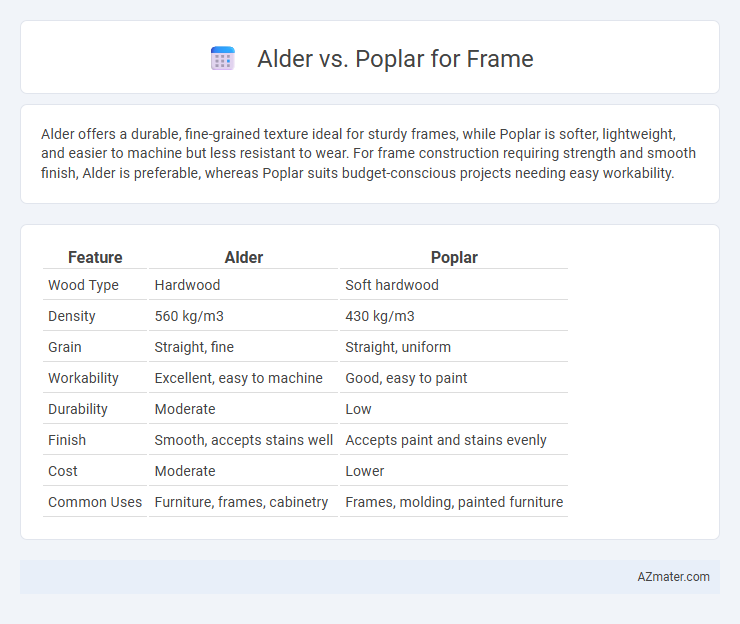Alder offers a durable, fine-grained texture ideal for sturdy frames, while Poplar is softer, lightweight, and easier to machine but less resistant to wear. For frame construction requiring strength and smooth finish, Alder is preferable, whereas Poplar suits budget-conscious projects needing easy workability.
Table of Comparison
| Feature | Alder | Poplar |
|---|---|---|
| Wood Type | Hardwood | Soft hardwood |
| Density | 560 kg/m3 | 430 kg/m3 |
| Grain | Straight, fine | Straight, uniform |
| Workability | Excellent, easy to machine | Good, easy to paint |
| Durability | Moderate | Low |
| Finish | Smooth, accepts stains well | Accepts paint and stains evenly |
| Cost | Moderate | Lower |
| Common Uses | Furniture, frames, cabinetry | Frames, molding, painted furniture |
Introduction to Alder and Poplar Wood
Alder wood, known for its fine grain and consistent texture, is a popular choice for furniture and cabinetry due to its smooth finish and ease of staining. Poplar wood features a straight grain and light color, making it ideal for painted frames and millwork where affordability and workability are important. Both hardwoods offer versatility in frame construction, with alder providing a warmer tone and poplar serving as a cost-effective, lightweight option.
Botanical Overview: Alder vs Poplar
Alder (Alnus genus) and Poplar (Populus genus) are deciduous hardwood species with distinct botanical characteristics impacting their suitability for frames. Alder trees typically feature smooth, grayish bark and produce nitrogen-fixing root nodules, enhancing soil fertility, while Poplar exhibits light-colored, soft wood with fast growth and broad, triangular leaves. Both species belong to the order Malpighiales but differ in wood density, grain patterns, and moisture resistance, influencing frame durability and finishing options.
Appearance and Grain Differences
Alder wood features a warm, reddish-brown hue with a fine, straight grain that offers a smooth, consistent texture, making it ideal for frames requiring a rich, elegant appearance. In contrast, poplar wood exhibits a lighter, cream to greenish tone with a more pronounced, irregular grain pattern that often includes knots and streaks, lending a rustic and casual aesthetic. The subtle color variations and uniform grain of alder provide a refined look, while poplar's distinctive markings create a more natural, varied visual appeal in framing applications.
Strength and Durability Comparison
Alder wood is generally softer and less dense than Poplar, resulting in lower overall strength and durability for framing applications. Poplar offers better resistance to wear, dents, and warping due to its harder, denser grain, making it more suitable for long-lasting structural frames. For projects requiring greater load-bearing capacity and longevity, Poplar is the preferable choice over Alder.
Workability and Machining
Alder wood offers excellent workability and smooth machining, making it ideal for frame construction with minimal effort and clean finishes. Poplar also machines well but is slightly harder and can produce a rougher surface, requiring more sanding and finishing. Both woods accept nails and screws efficiently, but alder's fine grain reduces the risk of splitting during assembly.
Weight and Density Factors
Alder wood has a density of approximately 560 kg/m3, making it lighter than poplar, which typically has a density around 450 kg/m3, but variations exist depending on the specific species. Poplar's lower density results in a lighter frame, which is often preferred for ease of handling and transportation. Weight considerations influence structural applications, with alder providing a balance of moderate weight and strength suitable for sturdy framing projects.
Cost and Availability
Alder wood is generally more affordable than poplar, making it a cost-effective choice for frames without compromising quality. Poplar is widely available across North America and Europe, offering consistent supply, while alder, primarily found in the Pacific Northwest, may have more limited regional availability. Both woods offer good workability, but alder's lower price and comparable availability make it a preferred option for budget-conscious framing projects.
Common Uses in Framing
Alder is commonly used in framing for interior projects requiring a smooth, fine-grained finish and moderate strength, such as furniture frames, cabinetry, and decorative moldings. Poplar is favored for its lightweight nature, ease of machining, and affordability, making it ideal for structural framing in non-load-bearing applications, prototypes, and painted surfaces. Both woods offer versatility but differ in durability and aesthetic appeal, influencing their selection based on project requirements.
Environmental Impact and Sustainability
Alder wood, known for its fast growth and renewable qualities, offers a lower environmental impact compared to poplar, which requires longer growth periods and more intensive management. Poplar's high carbon sequestration capacity contributes positively to sustainability, but its susceptibility to pests can lead to increased chemical use. Choosing alder supports sustainable forestry practices due to its adaptability and efficient growth cycles, making it a preferable option for eco-conscious framing projects.
Verdict: Which Wood is Better for Frames?
Alder offers superior stability and a smooth, consistent grain that makes it ideal for frame construction, especially when a fine finish is desired. Poplar is more affordable and readily available but tends to be softer and less durable, making it better suited for painted frames rather than natural finishes. Overall, alder is the better choice for high-quality, long-lasting frames due to its strength and aesthetic appeal.

Infographic: Alder vs Poplar for Frame
 azmater.com
azmater.com